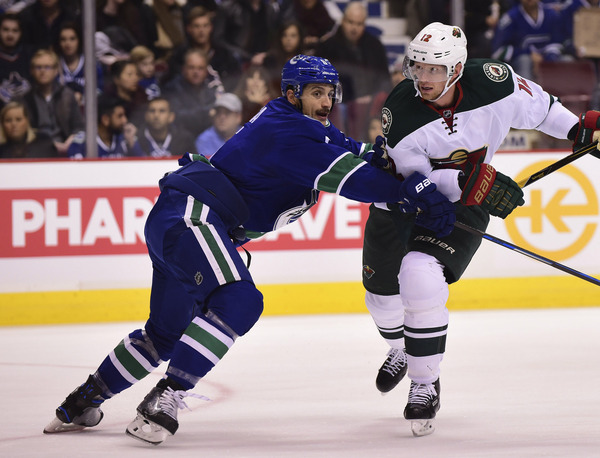
Photo Credit: Anne-Marie Sorvin – USA TODAY Sports
The romanticism of playing in a Canadian market certainly has its allure. It isn’t without its pratfalls either, and one needn’t look any further than the Canucks’ Luca Sbisa to see those very real implications.
Fairly or otherwise, Sbisa’s spent the entirety of his time in the Canucks organization at the butt end of many a fan and analyst’s jokes. His combined penchant for giveaways, Italian heritage and a perhaps a hint of assonance meant he wasn’t turning pucks over — he was delivering pizzas. Or rather, he was delivering Spizzas.
That hasn’t been the case this season. Sbisa’s playing the best hockey of his career, every bit invigorated by the offensive freedoms of a newly minted system and supported by the defensive patience their coaches preach.
“We [changed] a few things in our system. We focus more on giving them the outside and not so many chances from the high percentage spaces like the slot.” Sbisa told Canucks Army. “It’s a bit easier to contain them. Our forwards are a bit more involved in our defensive game. Especially on their entries. We used to be pretty aggressive at our blue line, whereas now we just focus on giving them the outside and the forwards are going to track back and apply as much pressure as possible.”
Though we often prefer to cite relative counts and the frequency of shots for and against, advances in predictive metrics have taken factors like distance into account to proportionately weigh the share of goals to expect with any given player on the ice. Sbisa leads the Canucks blue line by that metric with an expected goal percentage of 50.79%. He’s clearly improving with regards to limiting high-danger shots against.

Hockey is a zero-sum game, though. The fluidity of hockey is such that we can’t separate offensive contributions from defensive ones when gauging a player’s net value. If the Canucks — and Sbisa specifically — altered their approach at their blue line, intrinsically one might expect their shot, goal, etc. rates against to improve in exclusivity. That’s not been the case, though.
Among Canucks defenceman with 50 or more minutes of ice-time, only Troy Stecher’s had a better impact on his teammates’ ability to produce unblocked shot attempts at even strength. Sbisa’s FF60 Rel. Tm of 1.21 isn’t just good among defenceman — that’s eighth among qualifying Canucks period.
The biggest change for the Canucks defencemen has been their insistence on holding the blue line at all costs. Whereas previously they focused primarily on a weak-side hold to maintain offensive zone time, the Canucks have freed their defenceman to keep possession on each side with the third forward (known in hockey circles as the F3) instinctively covering their free-wheeling teammate.
Sbisa confirmed to me that level of autonomy and the impact it has on their ability to control play. “We focus a lot on having an F3 high, which gives our [defence] more [freedom] to go down the walls and keep the puck in.” Sbisa continued, perhaps with a nod to analytics “Like you’d say, the best defence is if you can [force turnovers] right away and keep it in their zone. I think we’ve been doing a pretty good job of that, too.”
The numbers back that assertion. Sbisa’s sporting the third-best score adjusted Corsi For of his career, sitting at a modest, if unspectacular 48%. It’s not break even. Far from it, even. In the context of playing for a team that’s collectively earned an identical mark, though, it’s not as bleak as it might appear at first glance.
Paramount now, to Sbisa and the Canucks alike, is whether he can maintain that resurgence. Before the Canucks lost Alexander Edler to a broken finger, Sbisa averaged just under 14 minutes a night at even strength. Since then, Sbisa’s played a cumbersome mark closer to 17:30 a night at evens.
Were that not enough, Sbisa’s adjusting to a new partner. Gone is the mountain man Nikita Tryamkin and in his stead steps Stecher. Sbisa maintains the transition’s been an easy one. “It’s been fun playing with him. He handles the puck really well, so I try to put it in his hands as much as I can. He usually finds the stretch guy easily.”
With Chris Tanev and Edler sidelined by injuries, the Canucks now play the youngest blue line in the NHL by average age. Sbisa, 26-years-old, is now the elder statesmen of Vancouver’s blue line. His place alongside Stecher is but a window into the mentorship role injuries have forced upon him, though.
Soft-spoken as always, Sbisa sheepishly remarked “I just want to play well and lead that way. I think everyone else in our [leadership group] is trying to do the same. Yeah, we are pretty young, but I think the young guys are playing like [veterans].”
The Canucks under Jim Benning have always placed a premium on the age group Sbisa resides. It’s why they’ve paid premiums at every turn to acquire players like Sbisa, and perhaps to a heightened extent Brandon Sutter and Erik Gudbranson thereafter. Moments like these validate their action to address that.
Youth brings with it excitement, but often at their team’s expense. In a year where the Canucks are preaching structure like door-to-door parishioners, Sbisa’s currying years worth of investment and providing insurance for the players that follow. He’s far from a perfect player, but he’s precisely what the Canucks need at this moment. And that’s something that seemed inconceivable as recently as last April.

